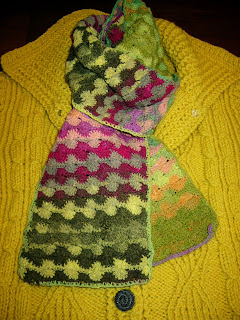I started to knit this cardigan on January 1, 2009. It is knitted with about 7.2 skeins of Peace Fleece in Khrushchev Corn Yellow. I love this shade of yellow.


I bought this yarn a few years back, way before Ravelry, when I visited yarn stores in Maine and New Hampshire with my knitting friends. Ordinarily, I would not consider yellow for myself, but this one was different. I am not a color theory expert and I have no idea what makes this yellow so different from the other ones. I fell in love and bought some skeins without having a particular project in mind.
Then, came Ravelry. After becoming a huge fan of Norah Gaughan, I would look for her designs and marvel them on Ravelry. Then I happened to see Norah's Tweedy Aran Cardigan from Interweave Knit magazine 2001/2002 issue in many different yarns and colors. Some of the finished projects were actually knitted with Peace Fleece. Then, I knew that I had to knit it with my yellow Peace Fleece. Given such a useful tool as Ravelry, I started to study the finished garments. I noticed that I liked versions which looked much longer than the others. I thought the longer versions show off waist shaping better. I also looked at button choices made by fellow knitters. Truly, Ravelry adds such an interesting dimension to knitting.
Now, about Norah's pattern. I love her fancy rib stitches: very stretchy and highly textured rib stitches. I almost thought of using them for entire sleeves but I decided that it might be too much for my poor wrists as this yellow Peace Fleece was quite hard on my hands in twisted stitches and cables. The photo below shows the texture of the fancy rib stitches best.

To make my life easier in executing fancy rib stitches, I took an extra step and rearranged stitches for easier knitting: Slip the first stitch to the right needle purl-wise and slip the second stitch knit-wise. Place these two stitches back to the left needle. Notice that the right leg of the second stitch is now easier to access from the back. Proceed by knitting into the second stitch’s right leg, and, without removing stitches from the left needle, knit the first stitch’s right leg. Remove both stitches from the left needle. Note to self: Fancy rib stitches eat up a lot of yarn. Estimate more yarn if I ever knit the same cardigan and use the stitch on sleeves.
Here are the changes I made: Lengthen the bodice by about 2" and to add more waist shaping (instead of 5 times, I did 7 times). Instead of making button holes involving just one yo, I chose to use a similar method I employed for Winter Wonderland Coat and did one-row button holes over three stitches. The modification was made to strengthen the right edge of the holes. Cast off the first stitch by slipping it over the last stitch on the right needle (it looks like k2tog). The next two stitches are cast off without using the working yarn by simply slip the stitch over the next stitch twice. Turn the work around and cast on four stitches using cable cast on method. Turn the work around and knit (or purl) the first stitch on the left needle with the last cast on stitch on the right needle. For this last step, the last cast on stitch must be transferred to the left needle first.
I found nice black horn buttons with notches etched on the surface, mimicking the fancy rib stitch pattern. Overall, this was a quite satisfying project.

I noticed that it goes very well with my Noro Sock Scarf recently finished.













